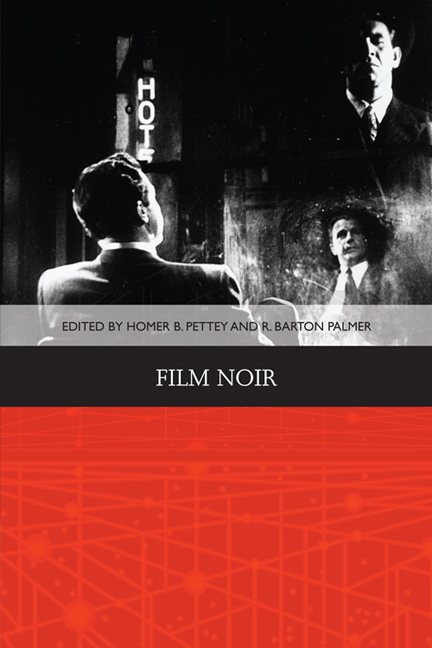Book contents
- Frontmatter
- Contents
- List of Illustrations
- Acknowledgements
- Notes on the Contributors
- Introduction: The Noir Turn
- 1 The Cinema of Uncertainty and the Opacity of Information from Louis Feuillade's Crime Serials to Film Noir
- 2 Warning Shadows: German Expressionism and American Film Noir
- 3 Hard-boiled Tradition and Early Film Noir
- 4 Cold War Noir
- 5 Noiring the Pitch: The Conflicted Soundtracks of Out of the Past, The Blue Gardenia and The Long Goodbye
- 6 Split Screen: Sound/Music in The Stranger/Criss Cross
- 7 Gender and Noir
- 8 The Subversive Shade of Black in Film Noir
- Postscript: A History of Our Writing about Film Noir
- Selected Book Chapters on Film Noir
- Selected Film Noir Books
- Selected Guide to Film Noir
- Index
6 - Split Screen: Sound/Music in The Stranger/Criss Cross
Published online by Cambridge University Press: 05 August 2016
- Frontmatter
- Contents
- List of Illustrations
- Acknowledgements
- Notes on the Contributors
- Introduction: The Noir Turn
- 1 The Cinema of Uncertainty and the Opacity of Information from Louis Feuillade's Crime Serials to Film Noir
- 2 Warning Shadows: German Expressionism and American Film Noir
- 3 Hard-boiled Tradition and Early Film Noir
- 4 Cold War Noir
- 5 Noiring the Pitch: The Conflicted Soundtracks of Out of the Past, The Blue Gardenia and The Long Goodbye
- 6 Split Screen: Sound/Music in The Stranger/Criss Cross
- 7 Gender and Noir
- 8 The Subversive Shade of Black in Film Noir
- Postscript: A History of Our Writing about Film Noir
- Selected Book Chapters on Film Noir
- Selected Film Noir Books
- Selected Guide to Film Noir
- Index
Summary
Robert Siodmak and Orson Welles are both central figures in the history of sound film. As Deborah Lazaroff Alpi observes, all of Siodmak's early sound films such as Abschied (1930) ‘are distinctive for their exceptionally sophisticated use of sound’. The same, of course, could be said about Welles’ early films. For example, with its expressive deployment of ‘lightning mixes’ and overlapping audio, ‘pan’ and ‘deep-focus’ sound, Citizen Kane (1941) is the prototype of the modern sound film. Siodmak and Welles are also central to the history of film noir. Siodmak not only helmed a number of seminal proto-noirs such as, in Germany, Der Mann, der seinen Mörder sucht (1931), Voruntersuchung (1931) and Stürme der Leidenschaft (1932) as well as, in France, Pièges (1939), but the ten films noirs that he directed in the United States between 1944 and 1949 – Phantom Lady (1944), Christmas Holiday (1944), The Suspect (1945), The Strange Affair of Uncle Harry (1945), The Spiral Staircase (1945), The Dark Mirror (1946), The Killers (1946), Cry of the City (1948), Criss Cross (1949) and The File on Thelma Jordon (1950) – ‘are regarded by many film critics and scholars as the quintessence of the genre’.
Although Welles’ contribution as a director to the genre is not nearly as voluminous as Siodmak's, his films noirs encompass almost the entire history of the genre, from Citizen Kane, arguably the Ur-American film noir, to Touch of Evil (1958), for many the baroque culmination of the classical period. At the same time, if it's true that Siodmak is more closely associated with film noir than Welles (Welles, like Hitchcock, tends to retain a certain genre transcendent status), none of Siodmak's films has received the sort of critical attention, especially with regard to their soundtracks, that The Lady from Shanghai (1948) or Touch of Evil, not to mention Citizen Kane, has. For this last reason, my attention in this chapter is split between subject (Welles/Siodmak) and topic (sound/music). More specifically, given the aforementioned critical literature on Welles, the first part concentrates on the play of silence and ambient sound in what has traditionally been considered both a minor Welles film and marginal film noir, The Stranger (1946).
- Type
- Chapter
- Information
- Film Noir , pp. 122 - 142Publisher: Edinburgh University PressPrint publication year: 2014

